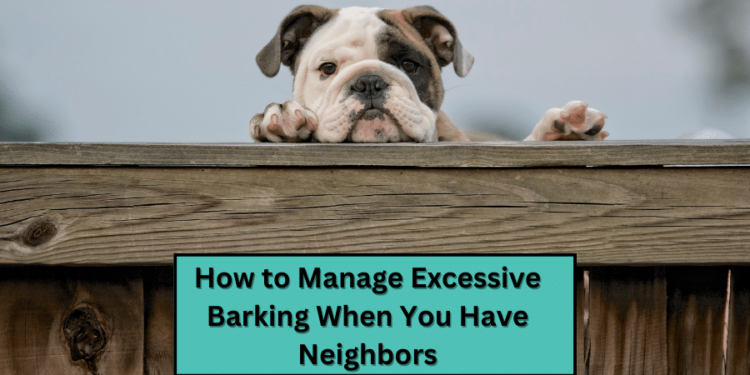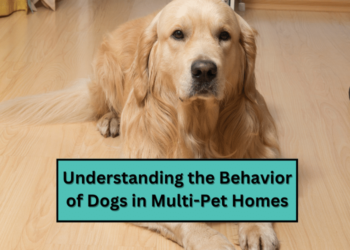For many dog owners living in communal settings or tight-knit neighborhoods, the joy of having a furry friend is sometimes accompanied by the challenge of managing their occasional loud outbursts. Imagine the scene: it’s a peaceful afternoon, and suddenly, your dog hears a car, another dog, or perhaps just the wind, and they’re off on a barking spree. Excessive barking can strain relationships with those living nearby and cause undue stress for everyone involved. The question that then begs an answer is: how to manage excessive barking when you have neighbors?
Throughout this article, we will explore effective strategies and solutions to ensure your dog is happy, your neighbors are understanding, and the community vibe remains harmonious.
Understanding the Causes of Excessive Barking
Before diving into the solutions, it’s crucial to grasp the root causes behind your dog’s excessive barking, especially when you have neighbors who might be affected by it. Dogs don’t just bark to annoy; barking is their primary means of communication. Recognizing what your dog is trying to convey can be the first step in addressing the issue.
Boredom
Just like humans, dogs get bored. A dog left alone for long periods or not given adequate exercise can resort to barking as a way to pass the time or release pent-up energy.
Territorial/Protective Behavior
If your dog sees or hears people or other animals close to their territory (your home), they might bark to warn them off. This behavior is particularly prevalent in breeds known for their protective nature.
Loneliness/Anxiety
Dogs are social creatures. Being left alone for an extended period can make them anxious, leading to excessive barking. Separation anxiety is a common cause of persistent barking when owners are away from home.
Attention-Seeking
Sometimes, your dog might just want your attention. This could be for food, play, or simply some petting. If they’ve learned that barking gets them what they want, they’re likely to keep doing it.
Fear
Sudden loud noises like thunderstorms, fireworks, or even the sound of a passing truck might scare your dog, causing them to bark.
Health Issues
On rarer occasions, excessive barking can be a sign of pain or an underlying health problem. If the barking is accompanied by other unusual behaviors, it’s worth a visit to the vet.
For those living close to neighbors, understanding these triggers is even more crucial. By addressing the root cause, you not only bring peace to the neighborhood but also improve the overall well-being of your furry friend. In the following sections, we’ll delve into strategies tailored to manage excessive barking when you have neighbors, ensuring harmony for all involved.
Effective Solutions to Minimize Barking
Managing excessive barking, especially with neighbors in close proximity, is pivotal for maintaining a peaceful living environment. Here are some tried-and-true solutions to help minimize your dog’s barking:
Training and Commands:
Use positive reinforcement training methods to teach your dog commands like “quiet” or “enough.” When your dog starts barking, calmly say the command, and when they stop barking, reward them with a treat or praise. Consistency is key; ensure every member of your household applies the same rules and commands.
Provide Physical and Mental Stimulation:
A well-exercised dog is less likely to bark excessively. Regular walks, playtime, and interactive toys can help alleviate boredom and expend energy. Puzzle toys and treat-dispensing toys can be especially effective for keeping them occupied.
Socialization:
Expose your dog to various people, animals, environments, and sounds from a young age. This can help reduce fear-based and territorial barking, as they become more accustomed to the stimuli around them.
Create Barriers:
If your dog often barks at people or other animals passing by the window, consider closing the curtains or placing a decorative film on the window. This limits their view and reduces territorial barking.
Desensitization:
For dogs that bark at specific stimuli (like doorbells or passing cars), desensitization can be effective. This involves gradually exposing your dog to the stimuli at a low level and rewarding them for staying calm, slowly increasing the intensity over time.
Anti-Barking Devices:
There are devices on the market, like ultrasonic bark controllers, which emit a high-pitched sound when barking is detected. This sound, inaudible to humans, distracts and deters dogs from barking.
Seek Professional Help:
If excessive barking continues to be an issue, consider hiring a professional dog trainer or behaviorist. They can provide tailored strategies and guidance specific to your dog’s needs.
Open Communication with Neighbors:
Keep an open line of communication with your neighbors. Inform them that you’re aware of the issue and are actively working on it. They’ll likely appreciate your proactive approach, and it may even foster a more understanding environment.
Remember, while the goal is to minimize unnecessary barking, it’s essential to ensure that your methods are always humane and constructive. Avoid punishment-based techniques as they can exacerbate the problem and create more behavioral issues. Understanding and patience, coupled with the right strategies, can help you manage excessive barking when you have neighbors, ensuring a harmonious living situation for all.

Using Bark Control Devices Responsibly
Bark control devices can be an effective solution for curbing excessive barking, but they must be used responsibly and ethically. When used correctly, they can serve as beneficial training tools. When misused, however, they can create stress, fear, and even aggression in dogs. Here’s how to ensure you’re using bark control devices in the best interest of your furry friend:
Choose the Right Device:
There are various bark control devices available, including ultrasonic devices, static collars, spray collars, and vibration collars. Research each type thoroughly, read user reviews, and consider consulting with a dog behaviorist to determine which might be the most effective and humane for your dog.
Avoid Shock Collars:
While they might be effective for some dogs, shock collars can be harmful and traumatic for many others. There are many alternative bark control devices that are less intrusive and more humane.
Test the Device:
Before using the device on your dog, test it on yourself or at the very least, familiarize yourself with its effects. This ensures you understand what your dog will experience.
Combine with Positive Reinforcement:
When your dog stops barking in response to the device, always follow up with positive reinforcement, such as treats, praise, or petting. This helps your dog make a positive association with the desired behavior.
Monitor for Signs of Stress:
Keep a close eye on your dog when introducing a bark control device. Signs of stress can include excessive panting, drooling, pacing, hiding, or trying to escape. If you observe these behaviors, stop using the device immediately.
Limit Duration of Use:
Don’t rely on bark control devices as a permanent solution. Use them as a training tool to curb excessive barking and combine their use with other training methods. Over time, you should rely on the device less as your dog learns to bark less.
Ensure Proper Fit:
If you’re using a collar-based device, ensure it fits properly. It shouldn’t be too tight, causing discomfort, or too loose, where it doesn’t function correctly.
Regularly Check the Skin:
For devices that remain on the dog, like collars, check your dog’s skin regularly for signs of irritation or sores.
Consult a Professional:
If you’re unsure about the best way to use a bark control device or if it’s suitable for your dog, consult a veterinarian or a dog behaviorist.
Communicating with Your Neighbors
Excessive barking can strain relationships with neighbors, especially if they’re disturbed by the noise. Proactive communication is key to maintaining harmony and understanding. Here’s how to approach and maintain a constructive dialogue with your neighbors about your dog’s barking:
Initiate the Conversation:
Before your neighbors come to you with complaints, approach them proactively. Let them know you’re aware of the issue and are taking steps to manage your dog’s barking.
Be Empathetic:
Understand that continuous barking can be disruptive. Listen to your neighbors’ concerns without becoming defensive. This shows that you respect their feelings and are committed to finding a solution.
Share Your Efforts:
Inform your neighbors about the steps you’re taking to address the problem, whether it’s attending training sessions, using bark control devices responsibly, or making environmental changes. This can reassure them of your commitment to resolving the issue.
Ask for Patience:
Training a dog to reduce excessive barking can take time. Ask your neighbors for their patience and understanding as you work on the issue.
Set Up a Communication Channel:
Provide your neighbors with your contact information, so they can reach out if the barking becomes problematic. This can be a phone number, email, or even a messaging app. Open lines of communication can prevent misunderstandings and foster a cooperative environment.
Compromise When Possible:
If your dog tends to bark excessively during specific times, like early mornings or late evenings, consider making adjustments to your routine to minimize disturbances during quiet hours.
Offer Apologies When Necessary:
If there was a particular incident where your dog’s barking caused a disturbance, such as interrupting a neighbor’s event or sleep, extend a sincere apology. This gesture can go a long way in maintaining goodwill.
Consider Organizing a Meet and Greet:
Sometimes, the unknown causes fear or annoyance. Letting neighbors meet your dog in a controlled environment can break the ice and create a friendlier atmosphere. It’s a chance to show that your dog isn’t just a noise-maker but a beloved family member.
Stay Updated on Community Rules:
Be aware of any community or housing rules related to noise and pets. This ensures you’re within your rights and responsibilities, and it can guide your actions more effectively.
Seek Mediation if Needed:
If communication breaks down, consider seeking mediation to address the issue. Neutral third parties can often help find solutions that work for everyone.
Considering Environmental Changes

The environment in which a dog lives can play a significant role in triggering or exacerbating excessive barking. If you’re trying to manage your dog’s barking, especially with neighbors in close proximity, assessing and modifying the dog’s environment can often lead to positive results. Here are some strategies and considerations for making effective environmental changes:
Secure Fencing and Visual Barriers:
If your dog barks at passersby or neighboring pets, consider installing a solid fence or adding visual barriers like privacy screens or tall plants. By limiting visual stimuli, you can reduce the triggers that set your dog off.
Safe Spaces:
Create a designated quiet space or ‘safe zone’ inside your home where your dog can retreat to. This space should be away from windows or doors where they might see outside triggers. Fill this space with their favorite toys, bed, and other comforting items.
Soundproofing:
If external noises like traffic, construction, or other neighborhood sounds are causing your dog distress, consider soundproofing solutions. This can include adding heavy curtains, using white noise machines, or investing in specially designed acoustic panels.
Engaging Toys and Activities:
A bored dog is more likely to bark. Make sure your dog has a variety of toys that cater to their instinctual needs, such as puzzle toys, chew toys, or interactive toys that keep them mentally and physically stimulated.
Safe Outdoor Engagement:
If you have a yard, ensure it’s safe and engaging. Features like interactive dog equipment, tunnels, or even a sandbox can give them a positive outlet for their energy and reduce barking triggers.
Routine and Predictability:
Dogs thrive on routine. Establishing a predictable daily schedule, including feeding, walking, playtime, and rest, can help reduce anxiety-induced barking.
Reduce Loneliness:
If you’re away from home often, consider getting another pet for companionship or hiring a dog walker or pet sitter to engage with your dog during the day.
Limit Access to High-Stress Areas:
If certain areas of your home or yard expose your dog to more stressors (like a window facing a busy street), limit their access to these areas, especially when you’re not home to comfort or distract them.
Use Natural Calming Aids:
Consider using natural calming aids like lavender scent, pheromone diffusers, or calming dog music to create a more serene environment.
Regular Exercise:
A well-exercised dog is often a quieter dog. Ensure your dog gets adequate physical activity tailored to their breed and age. This can reduce restlessness and boredom, both common causes of excessive barking.
By making thoughtful and strategic environmental changes, you can create a setting that reduces your dog’s need to bark excessively, thus fostering a more peaceful coexistence with your neighbors.
When to Seek Professional Help
Dealing with a dog’s excessive barking can sometimes be more than just a minor nuisance; it can be a sign of deeper behavioral or health issues. If you’ve tried numerous strategies and your dog’s barking remains disruptive, especially in a neighborhood setting, it might be time to consider seeking professional assistance. Here’s how to determine when professional intervention might be necessary and what it involves:
Persistent Behavioral Issues:
If your dog continues to bark excessively despite all your efforts, it might be indicative of deeply ingrained behavioral issues that require a specialized approach.
Barking Accompanied by Aggression:
If your dog’s barking is frequently accompanied by signs of aggression towards people or other animals, professional intervention is crucial for the safety of all involved.
Health Concerns:
Sometimes, excessive barking can be linked to health issues such as pain, hearing loss, or cognitive dysfunction syndrome in older dogs. If you suspect a health problem, a visit to the veterinarian is in order.
Separation Anxiety:
Dogs with severe separation anxiety can bark incessantly when left alone. This condition can be challenging to manage and often requires a multifaceted approach involving behavior modification and sometimes medication.
Adoption or New Environment:
Dogs adopted from shelters or those who have faced traumatic incidents might bark excessively due to past experiences. In such cases, a professional can offer tailored solutions to help the dog adjust.
Choosing the Right Professional:
There are several experts you can turn to:
- Veterinarians: They can rule out medical causes and, if necessary, refer you to a behavioral specialist.
- Certified Professional Dog Trainers (CPDTs): These experts can provide training solutions and techniques specific to your dog’s needs.
- Veterinary Behaviorists: For severe behavioral issues or cases where medication might be needed, a veterinary behaviorist is the ideal professional.
Consistency is Key:
Remember that even with professional guidance, consistency in implementing the recommended strategies is crucial. Ensure that all members of the household are on the same page.
Post-Training Follow-up:
After seeking professional help, regular follow-ups are essential. This ensures that the dog remains on the right track and any emerging issues are addressed promptly.
Conclusion
Living in proximity to neighbors brings with it a responsibility to maintain harmony, especially when managing excessive barking from our canine companions. This challenge can strain relationships with neighbors and leave dog owners feeling stressed. By understanding the root causes and implementing effective strategies, we can address the issue of excessive barking when we have neighbors close by.
Communication, patience, training, and, if necessary, professional assistance are the keys to achieving a quieter environment. Ensuring that our pets don’t disrupt the peace not only leads to happier neighbors but also to a happier, more contented dog.
Frequently Asked Questions (FAQ)

What triggers excessive barking in dogs?
Numerous factors can cause excessive barking, such as boredom, anxiety, territorial behavior, or even hunger.
How can I prevent my dog from barking without using bark control devices?
Regular exercise, mental stimulation, and consistent training are effective ways to prevent unnecessary barking.
Are bark collars safe for my dog?
While some bark collars can be safe when used responsibly and as directed, it’s essential to choose one that suits your dog’s size and temperament. Always consult with a veterinarian or a dog trainer before using one.
How can I effectively communicate with my neighbors about my dog’s barking?
Approach your neighbors calmly and politely. Listen to their concerns, reassure them that you’re addressing the issue, and maybe even establish a system where they can notify you if the barking becomes disruptive.
Can environmental changes reduce my dog’s barking?
Yes, reducing exposure to triggers, such as moving your dog’s bed away from a window or using white noise machines, can help reduce barking due to external stimuli.
At what point should I consider seeking professional help for my dog’s barking?
If you’ve tried multiple strategies and there’s no improvement in your dog’s behavior, it might be time to consult with a professional dog trainer or behaviorist.
Can anxiety lead to excessive barking?
Yes, dogs often bark excessively when they feel anxious, especially during events like thunderstorms or when left alone.
How do I differentiate between normal and excessive barking?
While dogs naturally bark to communicate, if the barking is persistent, disruptive, or seems to be for no apparent reason, it might be excessive.
Are certain dog breeds more prone to barking than others?
Some breeds are naturally more vocal than others, but individual temperament, training, and environment play significant roles in a dog’s barking habits.
How do bark control devices work?
Bark control devices detect your dog’s bark and emit a deterrent like a sound, vibration, or spray to discourage the behavior. It’s crucial to use these devices responsibly and ensure they don’t cause distress to the dog.


























Discussion about this post